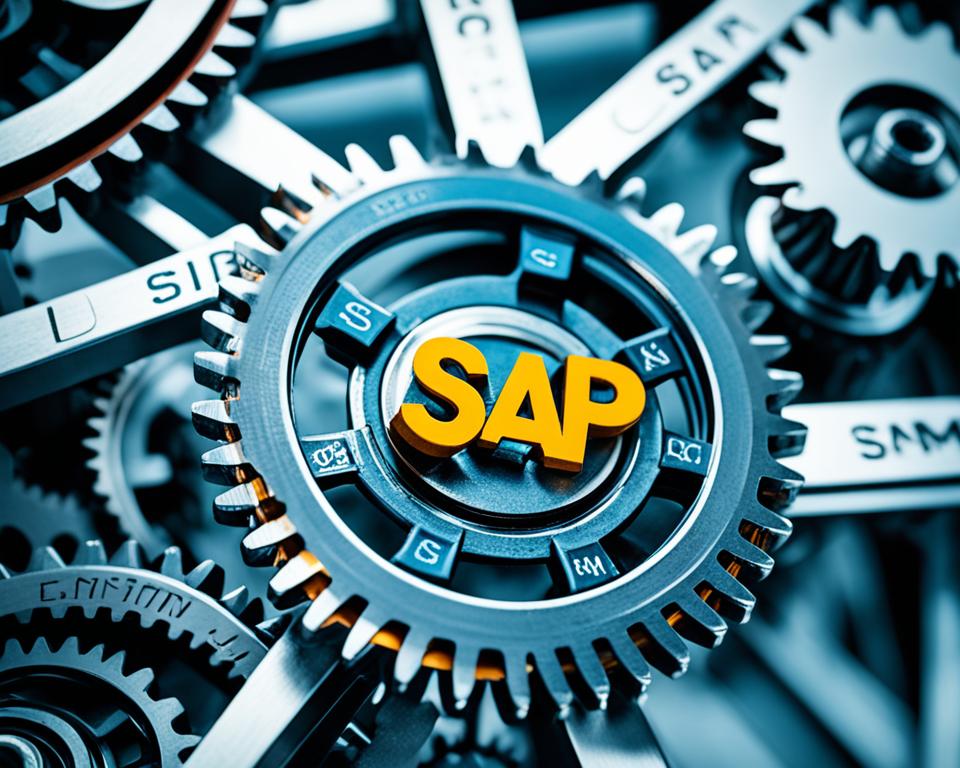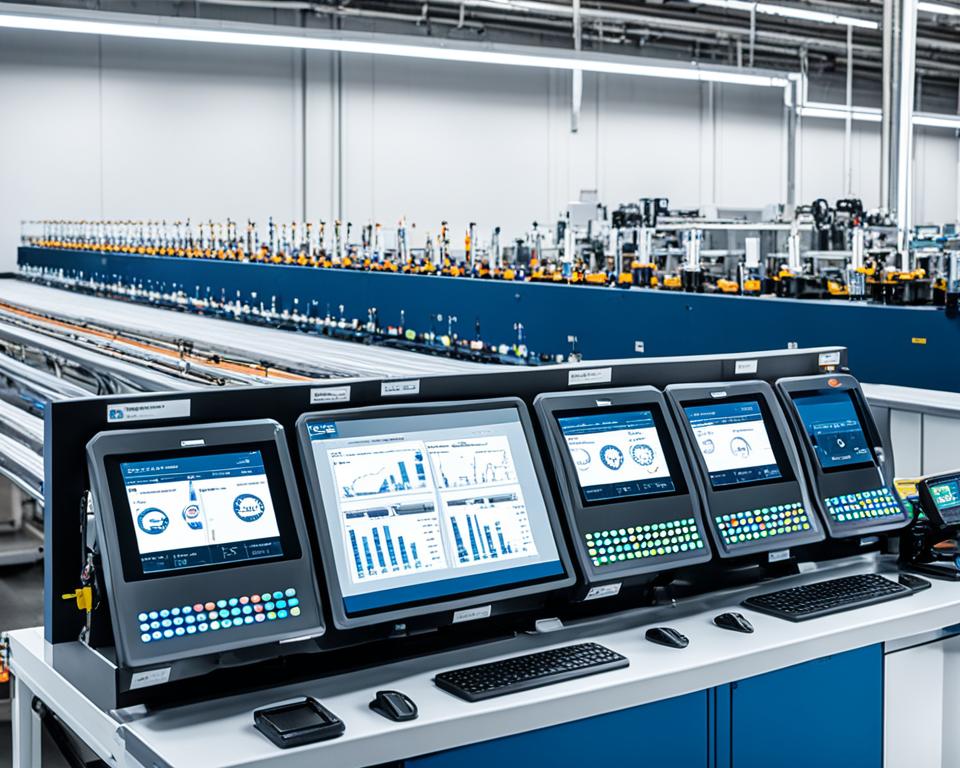How can embracing SAP Supplier Relationship Management (SRM) change how you manage procurement?
In today’s fast-changing market, being efficient is key. SAP SRM helps businesses improve their procurement efficiency, make processes smoother, and build strong supplier relationships. This tool makes communication better and helps manage suppliers well. As competition grows, having quick and flexible suppliers is more important. Using SAP SRM wisely can lead to saving costs and doing things better. For more on improving your procurement, see how Ariba can help with efficiency. Learn more here.
Key Takeaways
- SAP SRM makes procurement more efficient by streamlining processes.
- Improving how you work with suppliers leads to better communication.
- Using cloud-based solutions gives you an edge in the market.
- Tools like SAP SRM help cut costs.
- Being able to quickly adapt to changes is crucial today.
Understanding SAP SRM and Its Benefits
SAP SRM, or Supplier Relationship Management, is key for businesses of all sizes. It helps make procurement more efficient. By using SAP SRM, companies can streamline processes, improve how they work with suppliers, and get a better view of their procurement activities.
This system makes adding new suppliers easier for companies. It helps them manage their vendor network better. With SAP SRM, businesses can see how suppliers are doing and make smarter choices. It automates many manual tasks, cutting down the time and effort needed to keep up with suppliers.
Also, it helps improve communication between buyers and suppliers. This leads to stronger partnerships. Companies use tools like SAP Ariba to get better at procurement. They use data and reports to make their processes more efficient.
To show how SAP SRM works well, I’ve made a table with key benefits:
| Benefit | Description | Impact on Procurement Efficiency |
|---|---|---|
| Streamlined Processes | Reduces steps in procurement workflows. | Increases speed and lowers costs associated with procurement. |
| Enhanced Supplier Collaboration | Fosters better interactions and partnerships with suppliers. | Leads to improved quality and reliability of goods and services. |
| Data-Driven Insights | Utilizes analytics for informed decision-making. | Enables smarter sourcing and cost-saving strategies. |
| Improved Negotiation Strategies | Equips teams with accurate supplier performance data. | Enhances the possibility of obtaining favorable agreements. |
Key Features of SAP SRM Solutions
SAP SRM solutions give businesses a powerful toolkit to boost their procurement. They are made to make things run smoother, bring teams together, and follow the rules. The key parts include managing supplier relationships, strategic sourcing, and strong contract management.
Supplier Relationship Management
The supplier relationship management part of SAP SRM helps build strong partnerships with suppliers. Managing these relationships well leads to better performance. It lets me:
- Keep an eye on how suppliers are doing through data.
- Start projects that help both sides.
- Learn about what suppliers can do and their risks.
Strategic Sourcing
At the heart of better procurement strategies, strategic sourcing in SAP SRM gives me tools to find ways to save money. This lets me:
- Do a deep dive into the market to check out potential suppliers.
- Make suppliers compete to get better prices.
- Make processes for sending out RFPs and RFQs smoother.
Contract Management
Good contract management keeps things in line and lowers risks. SAP SRM has tools that help with:
- Automated workflows for contract approvals and renewals.
- Storing contracts in one place for easy access.
- Tools for reporting on contract performance and following the rules.
With these main features of SAP SRM, businesses can make their procurement better and more transparent.
How SAP SRM Supports Procurement Collaboration
In today’s fast-paced business world, building strong relationships is key. SAP SRM solutions help by improving communication between procurement teams and suppliers. They use the latest technology for sharing information in real-time. This is crucial for making quick decisions.
These solutions make working with suppliers better. They offer tools like shared dashboards and spaces for collaboration. This makes it easier to see how suppliers are doing and manage orders and inventory.
For example, when teams and suppliers can see the same data, they can quickly adjust to demand changes. This leads to shorter lead times and better stock levels.
- Real-time data access for quick decisions
- Better ways to give feedback on suppliers
- Clear view of how suppliers are doing
Using these tools every day helps improve constantly. Leaders in the industry show how SAP SRM can make procurement more efficient. By talking more with suppliers, companies build stronger partnerships. This helps the business succeed.
| Collaboration Tool | Benefits | Impact on Procurement Collaboration |
|---|---|---|
| Shared Dashboards | Enhanced visibility and tracking | Faster decision-making based on real-time data |
| Communication Channels | Streamlined messaging and feedback | Improved responsiveness to supplier inquiries |
| Supplier Performance Metrics | Objective evaluation and insights | Informed choices on supplier selection |
Integrating SAP SRM into Your Existing Systems
Adding SAP SRM to your current systems is key to better procurement. It’s important to make sure SAP SRM fits well with your business apps. Knowing the technical details and how they match up helps make SAP SRM work with your ERP system. This means data moves smoothly, giving you quick access to important info.
Compatibility with ERP Systems
When starting with SAP SRM, making sure it works with your ERP is crucial. Many ERP systems, like SAP ERP, Oracle, and Microsoft Dynamics, can connect with SAP SRM. Picking the right way to integrate lets you use shared data and processes better. Here are some important points to think about:
- Look at what your ERP can do now and see where SAP SRM can help.
- Check out solutions that help sync data in real-time.
- Talk to important people early to make sure everyone agrees on what’s needed.
Best Practices for Implementation
Putting SAP SRM in place needs careful planning and doing it right. Using the best ways to implement it makes the change smoother and helps your team adjust. These best practices are:
- Get key people involved from the start to get their thoughts and support.
- Offer detailed training to teach users about the new tools and how things work.
- Plan how to handle the changes in the organization from the new system.
Following these steps helps businesses move to SAP SRM smoothly and improve their procurement efficiency.

Spend Analysis: Leveraging Data for Better Decisions
Effective spend analysis is key for better budgeting in organizations. By using data, companies can spot spending trends. SAP SRM tools help with this, making financial and operational processes more efficient.
Tools Within SAP SRM for Spend Analysis
SAP SRM has tools for deep spend analysis. These tools help companies:
- Aggregate data from different sources for a full view of spending.
- Visualize spending patterns to quickly find trends and oddities.
- Generate reports that help in making decisions and increase transparency.
Using these SAP SRM tools, companies can make their processes smoother. This leads to better decisions on how to use resources, improving budget management.
Impact on Cost Reduction
Good spend analysis helps with cutting costs. With SAP SRM insights, companies can:
- Identify high-cost vendors and negotiate better deals.
- Eliminate unnecessary expenses through focused spending reviews.
- Optimize supplier choices based on performance and cost.
These steps lead to big savings and improve relationships with suppliers. Companies that use spend analysis in their procurement strategy see long-term gains in finances and agility.
Supplier Performance Management within SAP SRM
Managing supplier performance is key for better procurement processes. SAP SRM helps by using clear metrics and KPIs to check how well suppliers do. By looking at quality, delivery, and compliance, organizations can improve their supplier relationships and performance over time.
Metrics for Evaluating Suppliers
It’s important to set clear metrics for checking suppliers. Some key metrics include:
- Quality of goods/services delivered: This looks at defect rates and if they meet specs.
- On-time delivery: Keeping track of when shipments arrive is key for smooth operations.
- Compliance with industry standards: Suppliers must follow the rules and have the right certifications.
- Cost competitiveness: Checking prices against market rates makes sure you’re getting a good deal.
Continuous Improvement Processes
Continuous improvement in SAP SRM helps boost supplier performance. These processes let organizations:
- Spot areas where suppliers need to do better based on metrics.
- Work with suppliers to make plans to fix these issues.
- Keep an eye on progress and check performance regularly.
- Use data to shape future buying strategies.
Using metrics and continuous improvement, organizations can make a place where suppliers always aim to do better.

| Supplier Metrics | Performance Indicator | Improvement Strategy |
|---|---|---|
| Quality | Defect Rate (%) | Regular quality audits and feedback sessions |
| Delivery | On-time delivery (%) | Implementing stricter lead time agreements |
| Compliance | Certification status | Maintain updated compliance checklists |
| Cost | Price competitiveness | Conduct market price analysis regularly |
Operational Procurement: Streamlining Processes
In the world of operational procurement, making things more efficient is key. By making processes smoother, companies can save time and money. Tools like SAP SRM help by automating simple tasks. This lets procurement teams focus on important tasks that add value to the business.
Automation in Procurement Processes
Using automation tools in SAP SRM makes procurement easier. Tasks like making purchase orders and sending invoices can be done automatically. This not only makes things faster but also cuts down on mistakes. Here are some perks of using automation in procurement:
- Time Savings: Automation cuts out unnecessary steps, making procurement quicker.
- Cost Reduction: With less manual work, companies can save on labor costs and use resources better.
- Improved Compliance: Automated processes keep things in line with company rules and laws.
- Enhanced Data Accuracy: Automation means fewer mistakes, giving better data for making decisions.
Adding automation tools to SAP SRM makes procurement smoother and stronger. It helps companies take a strategic approach to procurement. This leads to better supplier relationships and helps meet business goals.
Supply Chain Optimization Using SAP SRM
My time with SAP SRM has taught me that making supply chains work better means working well with others. SAP SRM helps companies use SAP SRM strategies to work together better and react faster. This teamwork makes the supply chain work smoother, connecting suppliers, makers, and distributors in ways that boost performance.
Integrating Supply Chain Partners
Working together through SAP SRM means sharing information and talking in real time. This is key to making things run smoother. Tools like supplier dashboards and team platforms help companies match up better with what their partners need. This leads to:
- Increased visibility across the supply chain
- Enhanced decision-making capabilities
- Improved inventory management
These changes help businesses react quickly to new market trends and customer needs.
Eliminating Bottlenecks
SAP SRM is great at finding and fixing problems that slow things down. By looking at data and checking how things are doing, I can spot where delays happen. To fix these issues, we can:
- Standardize how we buy things
- Use automated workflows
- Improve how we check on suppliers
Getting rid of these problems makes things run smoother and more efficiently. The goal is to have a supply chain that can quickly adjust to new challenges and chances.

These changes make things better for customers and help companies stay ahead in the market.
| Strategy | Impact on Supply Chain |
|---|---|
| Integrating Partners | Increased collaboration and visibility |
| Data Analytics | Identification of bottlenecks |
| Automated Workflows | Faster processing times |
Real-World Success Stories with SAP SRM
Exploring SAP SRM success stories shows how businesses have changed their procurement processes. Each case study shares big wins in making procurement more efficient. It shows the real benefits of using SAP SRM in different industries.
Case Studies Highlighting Efficiency Gains
Many organizations have used SAP SRM to make their procurement smoother. Here are some key examples:
- Company A: This big manufacturer used SAP SRM to work better with suppliers and cut costs by 20%. They got better at talking with each other, making orders more accurate.
- Company B: A top retailer used SAP SRM to bring supplier contracts under one roof. This cut their procurement time by 30%. Their supply chain became more agile.
- Company C: In the pharmaceutical industry, this company reduced procurement spending by 25% with SAP SRM. They focused on managing suppliers better, getting better deals.
These stories show how SAP SRM boosts procurement efficiency and sets up companies for long-term success in strategic sourcing. To see these benefits, it’s important to understand the needs and challenges of working with suppliers and reaching your operational goals.
Challenges in SAP SRM Implementation
Implementing SAP Supplier Relationship Management (SRM) can be tough. It’s key to know the challenges to make it a success. Many organizations miss out on key steps that cause delays and inefficiencies. It’s vital to tackle these issues for a smooth transition.
Common Pitfalls to Avoid
Knowing the common pitfalls can help make the implementation go smoothly. Some big issues include:
- Inadequate planning: Not having a solid strategy can cause big problems.
- Insufficient training: Without enough training, employees may not adjust well.
- Poor change management: Resistance from people can slow down the adoption of SAP SRM.
- Neglecting data cleansing: Bad data can mess up results and make things harder.
Using good risk management can help avoid some of these problems. By learning from past projects, organizations can get better at spotting and fixing issues. This means being proactive, communicating well, and adjusting as needed. It makes dealing with challenges easier.
| Common Pitfalls | Impact | Risk Management Strategy |
|---|---|---|
| Inadequate planning | Increased costs and delays | Develop a detailed project roadmap |
| Insufficient training | Low user adoption rates | Implement comprehensive training sessions |
| Poor change management | Resistance from staff | Foster a culture of adaptability |
| Neglecting data cleansing | Compromised system performance | Perform regular data audits |

The Future of SAP SRM Solutions
The future of SAP SRM is set for big changes as it keeps up with new tech trends. New tech like artificial intelligence and machine learning will change how we manage supplier relationships. Companies need to think about how these new tools will work with their current systems.
Trends in Procurement Technology
Looking into procurement tech trends, we see automation and data analytics leading the way. Here are some big changes we’re seeing:
- AI is becoming more common for making predictions, helping with better decisions.
- Sharing data in real-time and making the supply chain more transparent.
- Creating platforms that make talking between stakeholders easier.
- Using advanced analytics to make suppliers work better and find better sources.
These changes mean we’re moving towards smarter systems. They help with buying things and build stronger ties with suppliers. For example, tools like Ariba Supplier Collaboration are leading the way. They offer better ways to check on performance and use data wisely.
Expert Tips for Maximizing SAP SRM Efficiency
Maximizing SAP SRM needs specific strategies to boost procurement work. I’ve learned that engaging with suppliers and working together is key. Building strong supplier relationships brings quick and lasting benefits in performance and trust.
Using data analytics is crucial for making smart choices. I suggest using SAP SRM’s analytical tools to understand spending and how suppliers perform. By following procurement best practices, companies can find ways to cut costs and make processes better. This leads to more efficient procurement.
It’s also vital to keep team members trained and supported. Regular training helps them stay up-to-date with SAP SRM’s latest features. This focus on learning keeps the team improving, making the whole process more efficient.
To wrap it up, my top tips are:
- Enhancing supplier collaboration
- Using data to make decisions
- Keeping teams trained and supported
By focusing on these areas, companies can fully use SAP SRM for their procurement needs. Working with SAP Ariba modules also helps by making processes smoother and improving how we manage suppliers.

Conclusion
In conclusion, SAP SRM boosts procurement efficiency and strengthens supplier relationships. We’ve seen how it simplifies processes and offers tools for analyzing spending and evaluating supplier performance. These tools help optimize supply chain collaboration.
Integrating SAP SRM into your operations can unlock great potential. It’s not just about saving money. It’s about building strong partnerships with suppliers for better performance. Using SAP SRM can lead to operational excellence, making your procurement department more competitive and agile.
When thinking about your procurement strategies, consider using SAP SRM. With the right tools and a focus on strategic supplier relationships, you can improve your procurement processes. This leads to lasting partnerships that benefit everyone involved.
FAQ
What is SAP SRM?
SAP Supplier Relationship Management (SRM) is a tool that makes procurement more efficient. It helps improve how we work with suppliers, communicate better, and make strategic sourcing choices. It’s key for managing suppliers and improving procurement operations.
How can I benefit from using SAP SRM?
Using SAP SRM can lead to better collaboration in procurement, improved contract management, and better spend analysis. This results in cost savings and stronger relationships with suppliers. It gives you a competitive edge in the market.
What key features should I look for in SAP SRM?
Look for features like Supplier Relationship Management, strategic sourcing, and contract management tools. These help optimize procurement, improve compliance, and find ways to save costs.
How does SAP SRM enhance communication with suppliers?
SAP SRM improves communication by offering tools for real-time information sharing and feedback. This is crucial for quick decision-making and better interactions with suppliers.
Is SAP SRM compatible with my existing ERP system?
Yes, SAP SRM works well with many Enterprise Resource Planning (ERP) systems. It improves performance and enhances operational capabilities.
How does spend analysis work within SAP SRM?
Spend analysis in SAP SRM helps identify spending patterns and optimize budgets. It uses tools for detailed data analysis, leading to cost cuts and better financial performance.
What metrics are used for supplier performance management?
SAP SRM uses metrics and KPIs to check suppliers on quality, delivery, and compliance. This ensures ongoing improvement and strong supplier relationships.
How can automation in SAP SRM facilitate operational procurement?
Automation in SAP SRM makes procurement more efficient by cutting down on paperwork and boosting productivity. This lets procurement teams focus on strategic tasks that add value.
What strategies does SAP SRM provide for supply chain optimization?
SAP SRM connects supply chain partners and uses strategies to remove bottlenecks. This leads to better efficiency and quicker response to customer needs.
Can you share examples of successful SAP SRM implementations?
Many organizations have seen big improvements in supplier relationships and procurement efficiency with SAP SRM. Case studies show significant cost savings and better operational results.
What challenges might I face when implementing SAP SRM?
You might face issues like integration problems, not getting stakeholders on board, or lacking enough training. Knowing these challenges helps in managing risks and making the implementation smoother.
What trends are shaping the future of SAP SRM?
The future of SAP SRM looks bright with advancements in artificial intelligence and machine learning. These will improve supplier management, efficiency, and data-driven decision-making in procurement.
How can I maximize the efficiency of SAP SRM?
To get the most out of SAP SRM, focus on engaging suppliers, using data analytics, and providing ongoing training and support. These steps will keep procurement operations efficient.


